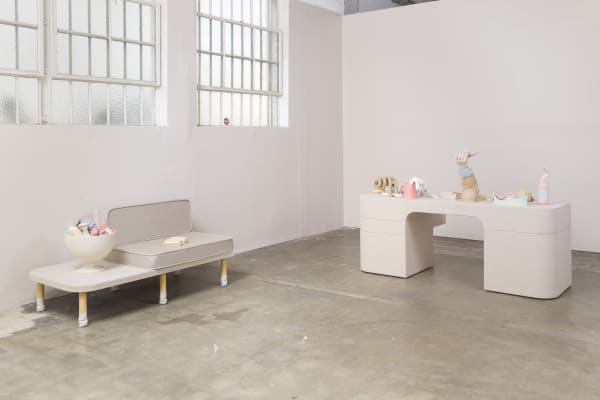Genesis Belanger: Coins for the Ferryman
François Ghebaly is pleased to announce Coins for the Ferryman, a solo exhibition by New York-based artist Genesis Belanger.
The liminal space—an anthropological term that refers to the time between the what was and the next—is a central theme in Belanger’s work. It is a place of transition, of waiting and not knowing what comes next. The show’s title, Coins for the Ferryman, alludes to crossing the threshold of the river Styx, a mythological liminal space where dead souls pay the ferryman to traverse from the realm of the living to arrive in Hades, the land of the dead.
Today we exist in another one of these liminal spaces, where as a society we maintain some degree of progressive forward movement (regarding sexual politics, race and a search for equality), yet we are still far removed from any complete ideal. Throughout this work, Belanger questions how we manage these in-between moments. She displays indulgences, baubles, self-medication and the remnants of self-obsession as possibly the defining products—and coping mechanisms—of our time.
Belanger’s exhibition consists of mixed media sculptures, predominantly stoneware and porcelain, baked in pastel fondant hues. The work often appears sun-bleached, existing as if viewed through a squint in the bright midday sun. This faded sunniness channels a wan rage, where Belanger suggests if you can’t afford to laugh at our problems, you’ll only want to cry.
Belanger has divided these objects and tableaux into two distinct areas within the gallery—a waiting room and a mourners’ wake.In the waiting room, several items of furniture sit silently in a kind of purgatory: a desk, a clock and two couches with cigarette butts for legs. On the smaller couch sits a half-eaten sandwich and a bowl of fruit with distinct bite marks taken out of the decomposing mass. The larger one is flanked by two lamps where lips in relief are forcibly pursed by fingers into a smile. The desk is scattered with the tropes of busywork (calculators, phones and stationery) and the human indulgences that allow us to tolerate this kind of drudgery (snacks and drugs). At the center, a female arm—well-muscled but prim in a blouse—reveals a poised hand holding a perfectly pink wiener sausage aloft. To Belanger, here is another example of a strong woman maintaining the current status quo.
Entering the wake, we see a simple bed frame piled high with four plump mattresses. Atop the bedding rests an exaggerated and simplified hairbrush with neatly manicured fingers standing in the place of bristles. Like in Hans Christian Andersen’s The Princess and the Pea, Belanger asserts that a woman’s most desirable quality—to men at least—is sensitivity. And in a feely brush object, she has created the ultimate tool—or machination—of this desired female characteristic, here waylaid upon a plush pedestal.
A large table littered with liquor bottles, flowers, pill jars and comestibles stands nearby. Part memorial, part outward display of grief, this literal tableau seeks to find comfort in mourning and, in the case of one bottle modified into a Molotov cocktail on the surface, a catharsis in revenge and violence.
To speak of female desire, Belanger installs a pink pouffe with a contorted pair of slender manicured fingers wrapped in large rings raised from its surface. Their stretched exaggeration forces a similarity to long legs where, curiously, at the base of each finger is a space devoid of detail that calls to mind the buffed crotch of a Barbie doll—glamour minus power. The jewelry on the fingers and around the pouffe references an era when a woman’s only means of amassing wealth were from trinkets and jewelry, Belanger hinting at a sense of “beguiling oppression.”
On the floor nearby, two shoes (masculine in form, yet softened with pink and blue pom-pom socks) step timidly away from the scene towards a large curtain spanning the entire back wall of the gallery. From the edge of the fabric, a neatly manicured hand pulls the curtain aside, beckoning at a larger narrative—and possible conclusion to our liminal experience—beyond the fold. Progress, perhaps? We’ll see.
Genesis Belanger was born in 1978 in the United States of America. She holds an MFA from CUNY Hunter College and a BFA from the School of the Art Institute of Chicago. Belanger was recently the subject of a New Museum solo exhibition, Holding Pattern, curated by Margot Norton, and will present a solo exhibition later in 2019 at the Aldrich Contemporary Art Museum in Ridgefield, Connecticut. Belanger was Artist in Residence at Pioneer Works, Brooklyn, in 2017. Her practice has been covered in the pages of the New York Times, The New Yorker, Artforum, The Art Newspaper, and Galerie Magazine. Coins for the Ferryman is her first solo exhibition at François Ghebaly. Belanger lives and works in Brooklyn, New York.
-
 Genesis Belanger, Reception, 2019
Genesis Belanger, Reception, 2019 -
 Genesis Belanger, God's Bounty, 2019
Genesis Belanger, God's Bounty, 2019 -
 Genesis Belanger, Waiting-Room, 2019
Genesis Belanger, Waiting-Room, 2019 -
 Genesis Belanger, One For Me And One For My Friend, 2019
Genesis Belanger, One For Me And One For My Friend, 2019 -
 Genesis Belanger, Sterling, 2019
Genesis Belanger, Sterling, 2019 -
 Genesis Belanger, Matchless, 2019
Genesis Belanger, Matchless, 2019 -
 Genesis Belanger, On the Road, 2019
Genesis Belanger, On the Road, 2019 -
 Genesis Belanger, Big Sleep, 2019
Genesis Belanger, Big Sleep, 2019 -
 Genesis Belanger, Hostess, 2019
Genesis Belanger, Hostess, 2019














